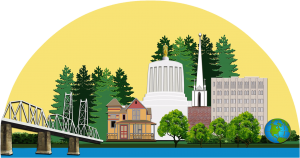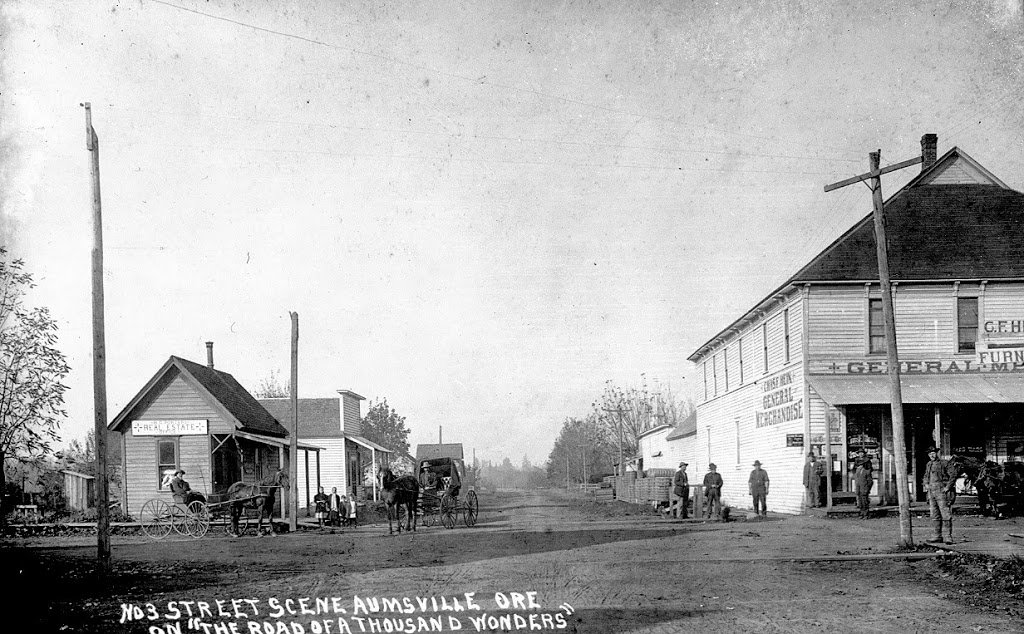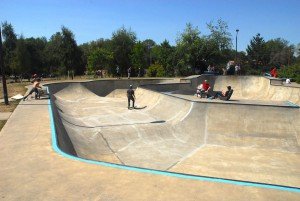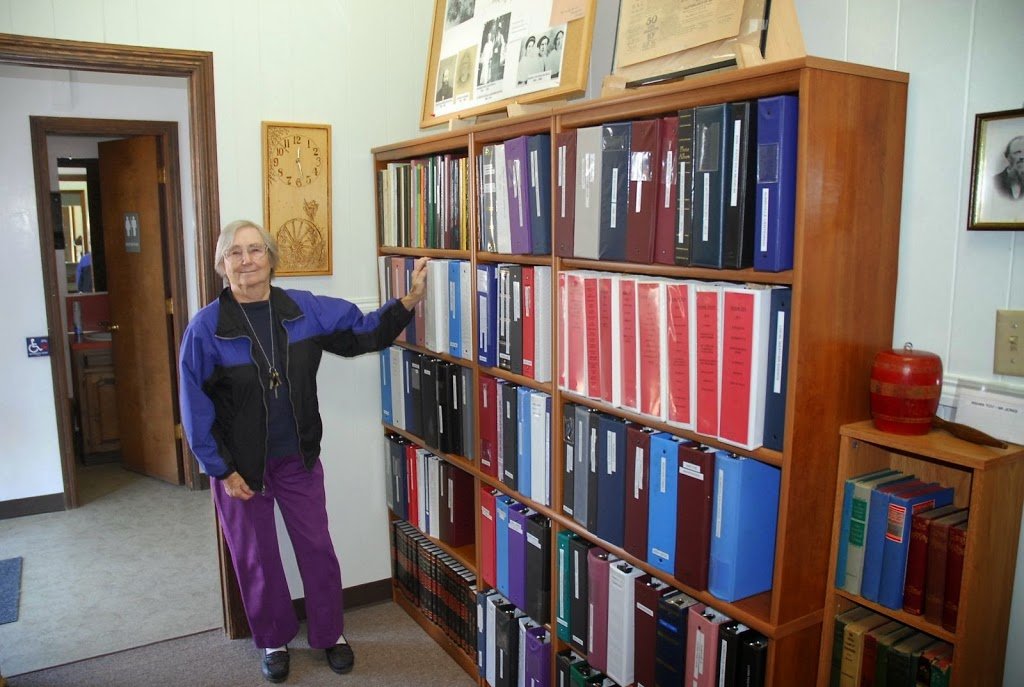We began our Marion County visits in August, a perfect time to visit Aumsville. The Sunday afternoon weather was fine and the Corn Festival was underway. Driving from Salem, Tom took various backroads unfamiliar to us, and it was just by accident that Porter Boone Park and the festival sprang up before us as we entered the city near 11th Street. But the fair was only one of four attractions in Aumsville we can recommend.
First, a bit of local history:
As early as 1843, Oregon immigrants cultivated land in this area. Within a dozen years, William Porter, with family and neighbors, erected a small frame building in 1855 the Mill Creek Church of Christ on his Donation Land Claim that served as a church and school in the same time frame. A post office followed (1862), some distance away, and then the important general store (1866) where most of life’s necessities could be purchased – grain for the farm animals, nails, rope, lanterns and lantern oil, material and thread for making clothing, salt, flour, and other food.
In 1893, a school was built between Main and Church Streets on 9th Street and was called the “Old Wooden School”. In 1922, the Amos Davis School was opened and was used until 1972. Cornelia Turner Davis, widow of Amos Davis, donated money to build the school. It contained elementary grades through high school. (She also donated money to build Turner School, the Christian Church Tabernacle, and what became the Turner Memorial Home.) Mrs. Turner stipulated that there would be no dancing and portraits of herself and her husband would be displayed in the school.
(Carol Roller supplied much of this historical background.)
Few historic structures can be seen in Aumsville today, but here’s a short tour that will reveal a few as you pass the municipal and business facilities. If you approach the city by Highway 22, it’s about 12 miles southeast of Salem. Entering the city at 1st Street, you see the historic railway crossing. The railway once had a depot here, between First and the tracks, north of Main, but that is gone. Across the street from that site, however, is a branch of the Riverview Community Bank that has an outreach program to serve the city’s residents. Traveling west on Main Street, the 1978 Post Office is near 3rd Street and the 1974 fire station is on 5th Street. In the 500 block, the city administration operates out of the fine new 2009 City Hall with a faux brick facade matching the old city facility, now the Aumsville Museum and History Center. A Community Center completes this municipal complex. In the next block is the newly enlarged Nichol Plumbing building, rebuilt after considerable damage by the December 14, 2010 tornado that touched down in the center of the city. Photographs in the museum display the demolition from winds that destroyed homes and caused substantial damage to businesses. Fortunately, the only damage to city-hall-police complex was a broken window. Two historic residences are near 7th and 8th Streets: The Jensen house on Main and the Swank home, a block south near Mill Creek. This is another must-see, if only from the exterior: the Swank mansion is reputed to have 40 doors, but it is a private home, not open to the public. An undated historic photograph shows an aerial view of area when the flour mill was across the road from the Swank residence. The elementary school is now on Eleventh Street and is part of the Cascade School District. (Since 1950, classes for grades 6-12 have been held at a location central to the district.) To the east of 11th Street is the Maude Porter Boone Park where the annual Corn Festival is held. And now we are back where we first entered the city on our first visit.
Although the population is only 3,584 and encompasses less than one square mile, the residents are proud of local services not always found in a small town. It prints a monthly newsletter, which is delivered, free of charge, to every residence in the city. Civic groups include the Aumsville Corn Festival Committee, Aumsville Historical Society, Cascade Country Quilters, 4H Groups, Boy Scouts, Aumsville Area Seniors and the Aumsville Community Theatre Group.
Children are a focus of attention. There are various day camps, a summer schedule of free movies in the park, an Easter egg hunt, and at Christmas Santa on the fire truck tours the entire city, distributing a lunch sack of candy and treats to any child who comes to the curb. Countless volunteers help with community activities and every summer the city holds a volunteers’ picnic to honor them.
Aumsville currently has an award winning monthly newsletter and a city website.
Here are four, not-to-be-missed visitor attractions in Aumsville.
The Brian Haney Memorial Skatepark (Mill Creek Road and 11th Street) draws visitors from all over the world. It was built in memory of Brian Haney, a young man killed in a car accident on his way to skating in 1997. Skateboarder magazine rated the park number one on their list the “Five Gnarliest Skateparks” in 2003. Funding for the project came from youth fundraisers, businesses, city park SDC funds and a matching grant through Oregon State Parks. Oregon National Guard donated labor and equipment plus endless hours of volunteer effort.
Even if you are not a skateboarder, it’s fun to watch.
The Historical Society maintains the Aumsville Museum & History Center displaying local artifacts and city historical records.This well-organized and attractive site is an excellent introduction to Aumsville’s community spirit. The museum is located at 599 Main Street and is open 11 am to 2 pm on Saturdays, April through October. Museum facilities are also available by contacting the Aumsville Historical Society for an appointment.
Each Tuesday, after a city was featured in that Sunday’s Statesman Journal, KMUZ broadcasted “Marion County 20”. To learn more about Aurora, listen to the podcast listed on the station’s website.




